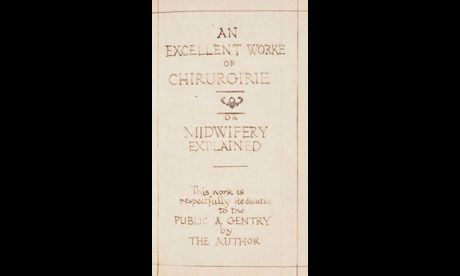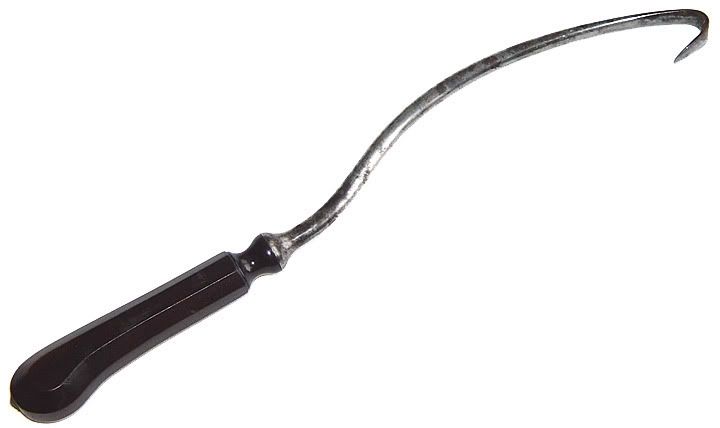A truly unique tome is currently up for auction in the United Kingdom.
Observations in Midwifery, by Percival Willughby is a record of 150 case histories attended by Willughby over his years of practice. Written in about 1670 it was not published until many years after his death in 1863. Only 100 copies were produced, 17 sold, and only 2 remain in existance today.
Willughby was born in 1596. He was admitted to the Royal College of Physicians in London in 1640. He practised in London, Stafford and Derby before finally setting up an obstetric practice in Derby. He practiced until his death in 1685, aged 89.
Observations in Midwifery was intended as a handbook to teach midwives about how to handle difficult labours and births. Willughby had found many births he attended made more complicated by inexperienced and overly officious midwives and advocated a more natural approach.
The book itself makes a fascinating read and gives an insight into some of the horrors that was childbirth in the 17th century, not to mention the high maternal and infant mortality. For example the case of Emme Toplace, who thought to be dead, was buried prematurely and gave birth in a coffin.
"Emme, the wife of Thomas Toplace, was five dayes in labour.
The sixth day, shee had a medicine given her, to ease her paines, by a
Doctor of Divinity, pretending some small skill in physick. After the
taking of the medicine, in the evening, shee was supposed to bee dead;
and, after nine a clock that night shte was buried.....Severall women were much troubled at her hasty buriall, and
thought, That shee was not dead....The earth was cast off from the coffin, and the coffin was found
somewhat opened, where, formerly, the bords were joined together, with
a ridg at the top, and the coffin was hot.
After that, it was opened ; the woman's hand was seen bare, and
some saw hurds lying on her breast, and in her hand, with which her
mouth had been stopt by her husband's friends. And it was beleeved,
That the buried woman had pulled those hurds out of her mouth with
her own hand, after that shee was interred.
Another woman put downe her hand, and found a child, delivered
in the coffin, and descended as low as her knees, or lower, with one
hand in the mouth, and the other extended by the side, and the after-
burden was also come from her."
Sadly this woman and her child did not survive the birth.
Similarly it gives insight to Percival Willughby himself. Cases show he treated both the very poor and the very rich without discrimination. On one occasion he attempted to intervene with judge about a "natural fool" who miscarried during the night as she did not really know what labour was. Willughby desperately attempted to prevent the judge from gaoling her.
Unfortunately the book also depicts the horrors that was obstetrics during the 17th century. This was prior to the caeserean section, forceps, or any kind of intervention that might help with obstructed labour. The only tool available was a crotchet. (This might be the point those of you with delicate dispositions should look away).
This instrument, as you can probably discern, was essentially used to destroy the foetus following death to facilitate delivery. As the following case from Observations in Midwifery illustrates, often the mother would not survive this procedure either.
"Mrs. Middleton of Wandsly had suffered several! dayes
great paines in labour, and was somewhat distracted with her sufferings.
Shee was a little woman, and her child was too great for the pas-
sage.... That day I placed her againe kneeling, and rinding that the child
was dead, knowing that I could not alter the birth, I used the crotchet,
by which the skull was much broken in pieces, yet it would not come
easily. It did also stick greatly at the shoulders and at the breast.
I was necessitated to intreat the assisting women, to turn the lips
of her body over the child's limbs, by putting their ringers between
her's, and the child's body, whilest that I drew the child with my hand,
and instrument.
This force was continued untill the child was drawn past the
navell. Afterward, the rest of the body, with the afterbirth, was easily
procured. So shee was laid in her bed. Shee lived
some five dayes, after her delivery.."
One copy of this book is held by the Royal Society of Medicine (and a full transcript is available online). The other is being auctioned off.
If anyone has 20-30 thousand pounds I would greatly appreciate it if they could loan it to this intrepid reporter. I would really like to own this book!
1. http://www.rsm.ac.uk/welcom/feature-willughby.php
2. http://www.guardian.co.uk/books/2012/jun/28/observations-in-midwifery-book-auction#
3. http://www.archive.org/stream/observationsinmi00will/observationsinmi00will_djvu.txt



We have much to be grateful for! Wow.
ReplyDelete:). The whole text is just FASCINATING. Gruesome, but fascinating.
DeleteI'm glad I've got forceps and an operating room, though.
I wanted to say that I have loved this blog. I have bookmarked it and hope to see more, I am a doctor manque - the daughter and granddaughter of doctors and the keen reader as a child of tomes like French's Differential Diagnosis 1911 edition which contained all the illness and how little meaningful treatment was available. My grandfather was a pioneer anaesthetist in Australia also. Many books were around concerning the earliest uses of ether. I was a poor mathematician so medicine was out for me, law instead. But I love history and medical and social domestic history is my lazy indulgence.I could read it all day.I love your analyses. Thank you so much. Best regards Janet
ReplyDeleteAs the auction purchaser of this incredible piece of medical and obstetrical history, I can confirm that this manuscript is fascinating....Dr. Willughby was certainly ahead of his time, as man-midwifery was in the earliest stages of development in Europe. I was so pleased to read your fine article on it in your blog. Perhaps a great deal of my interest comes from the fact that I am an Obstetrical, Placental & Perinatal Pathologist, one of the very few who work in this subspecialty! Keep up the great work on your blog! Best regards, Dave
ReplyDelete